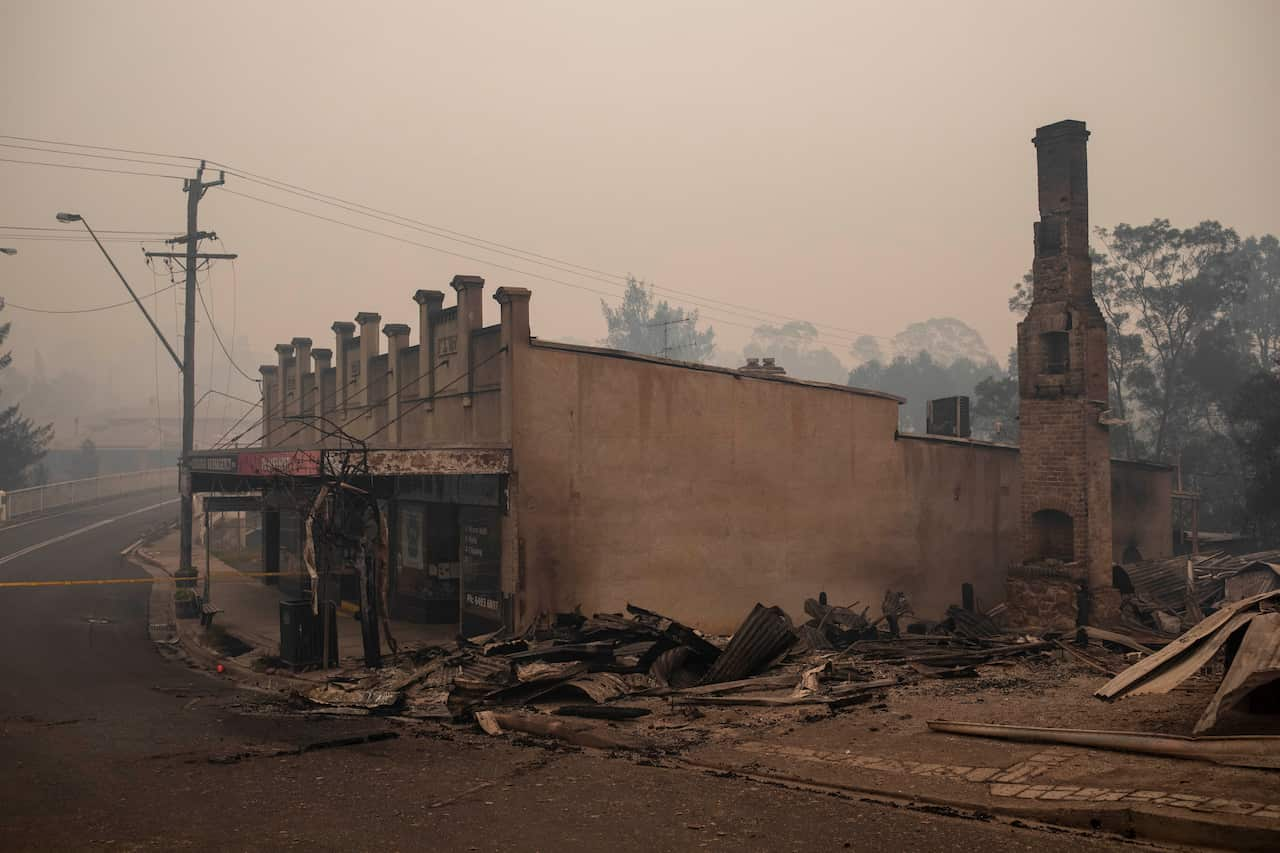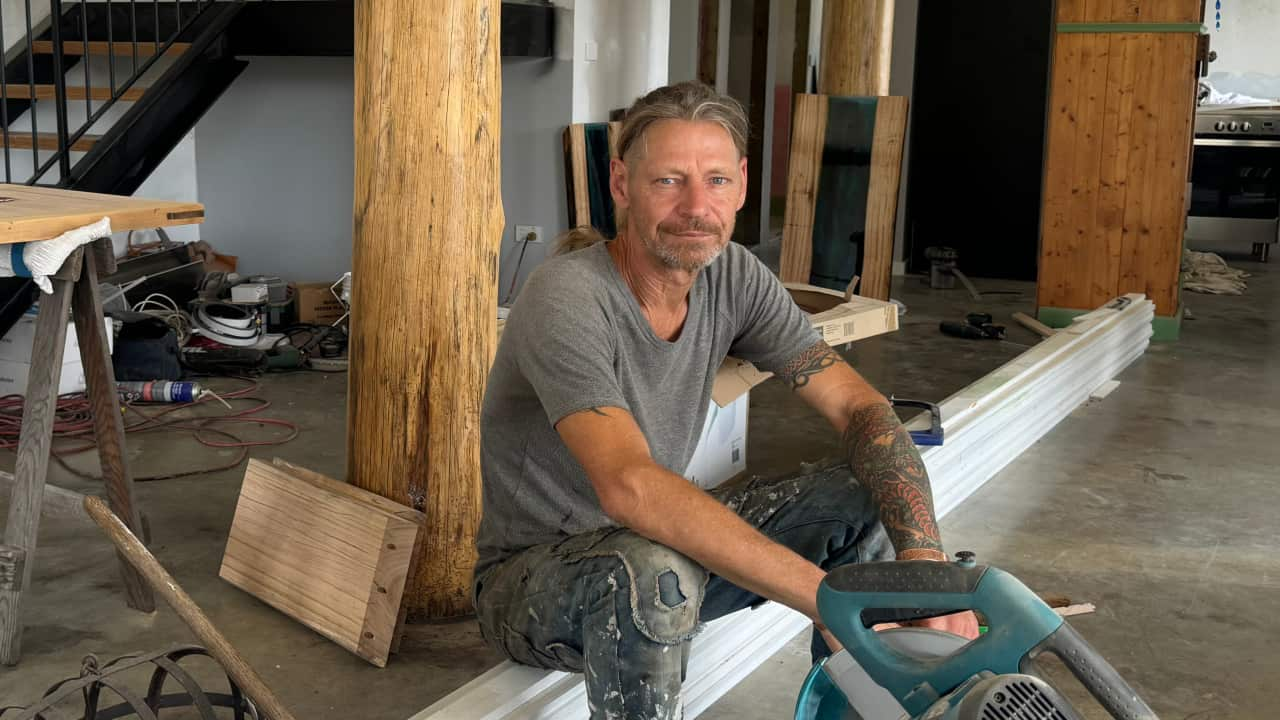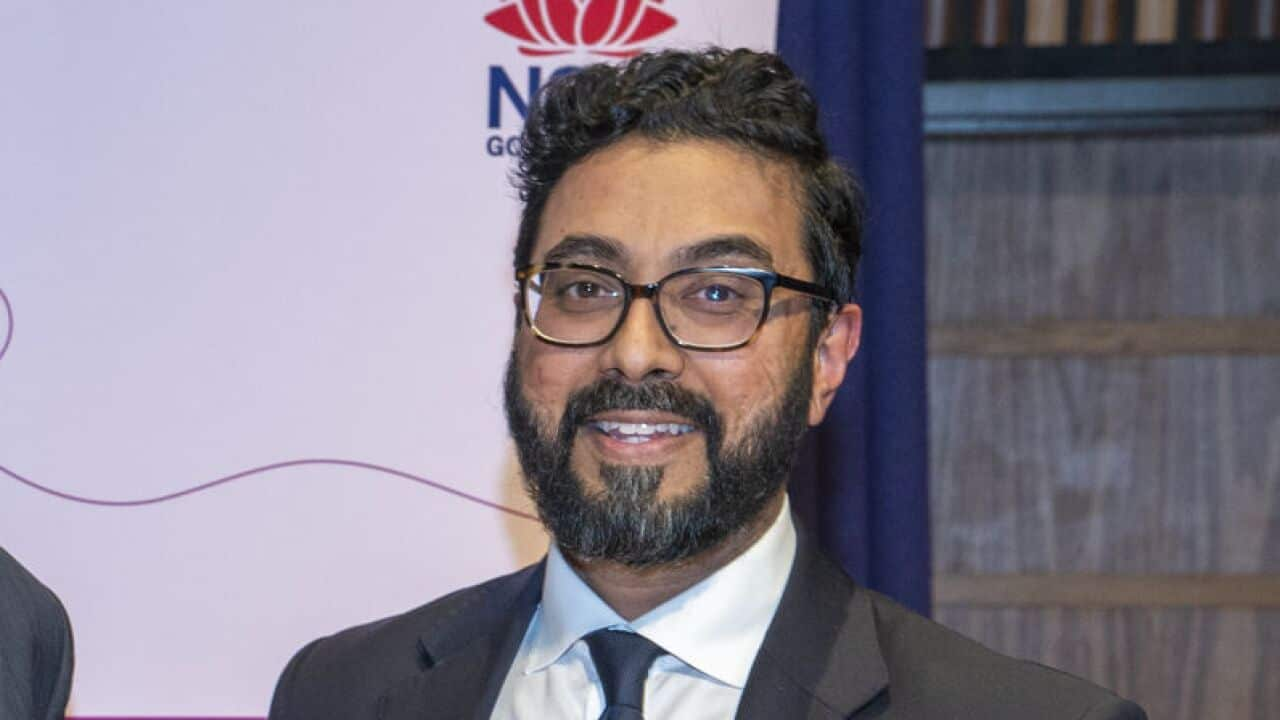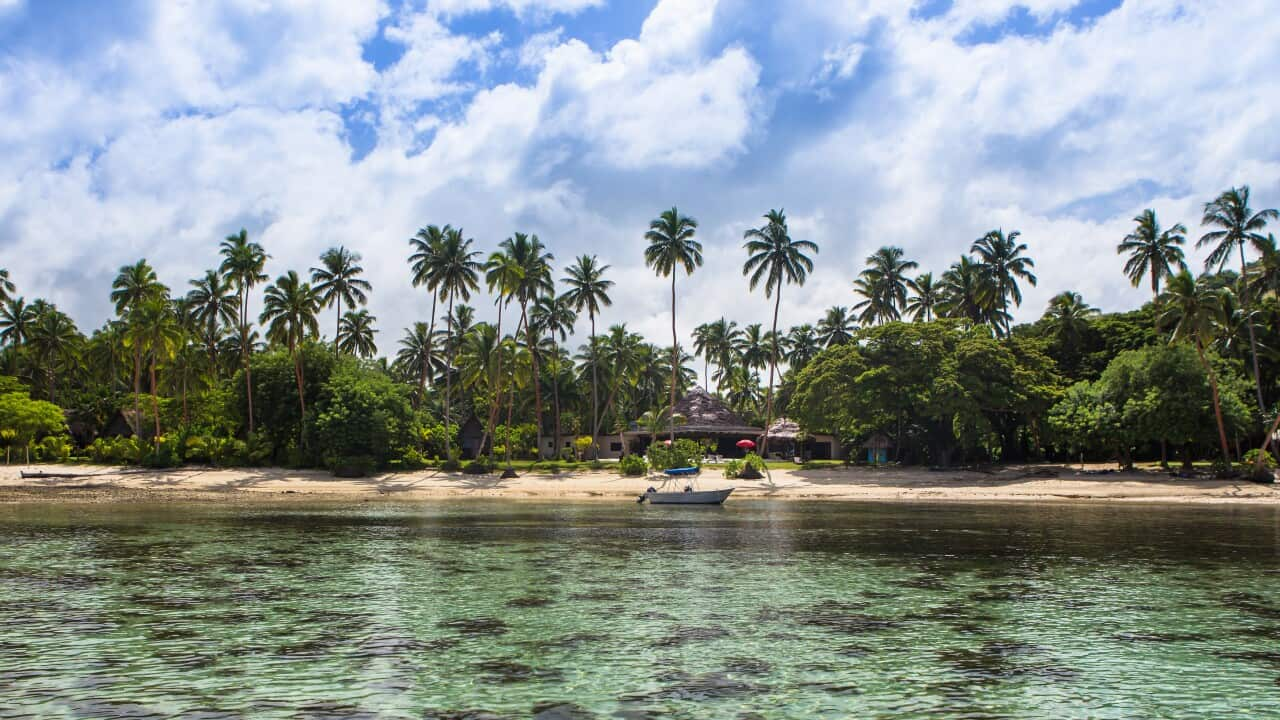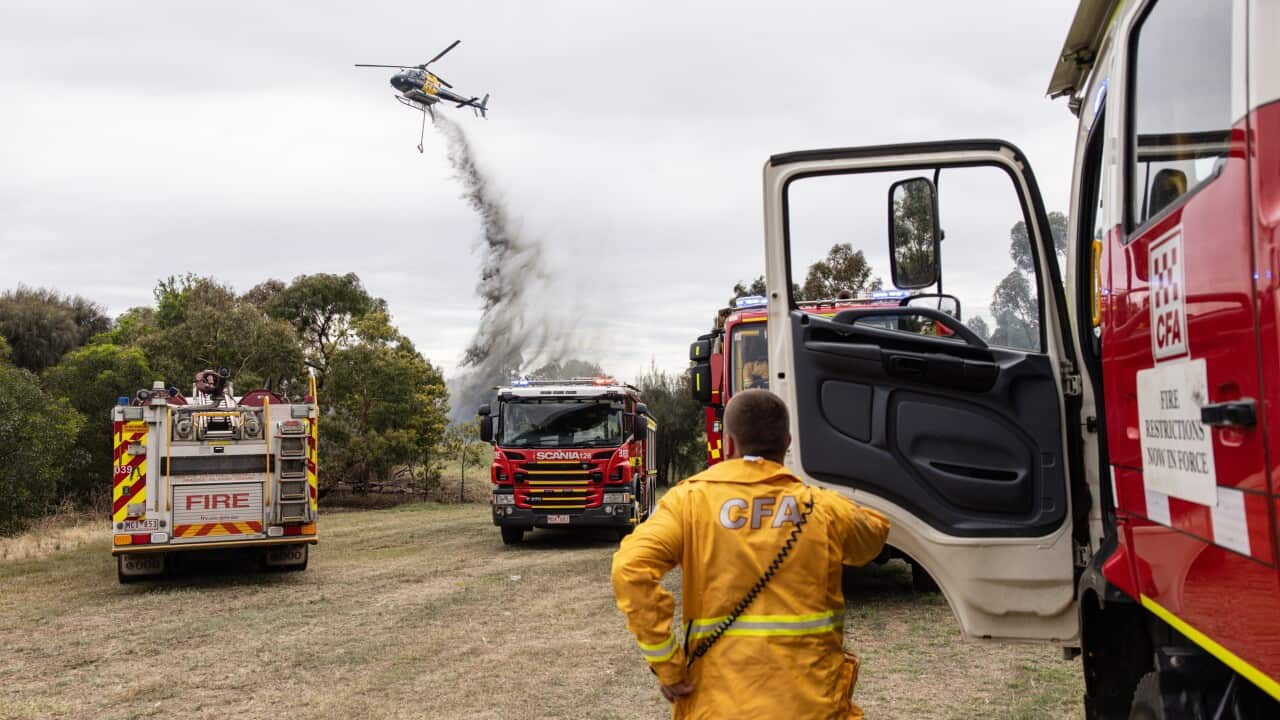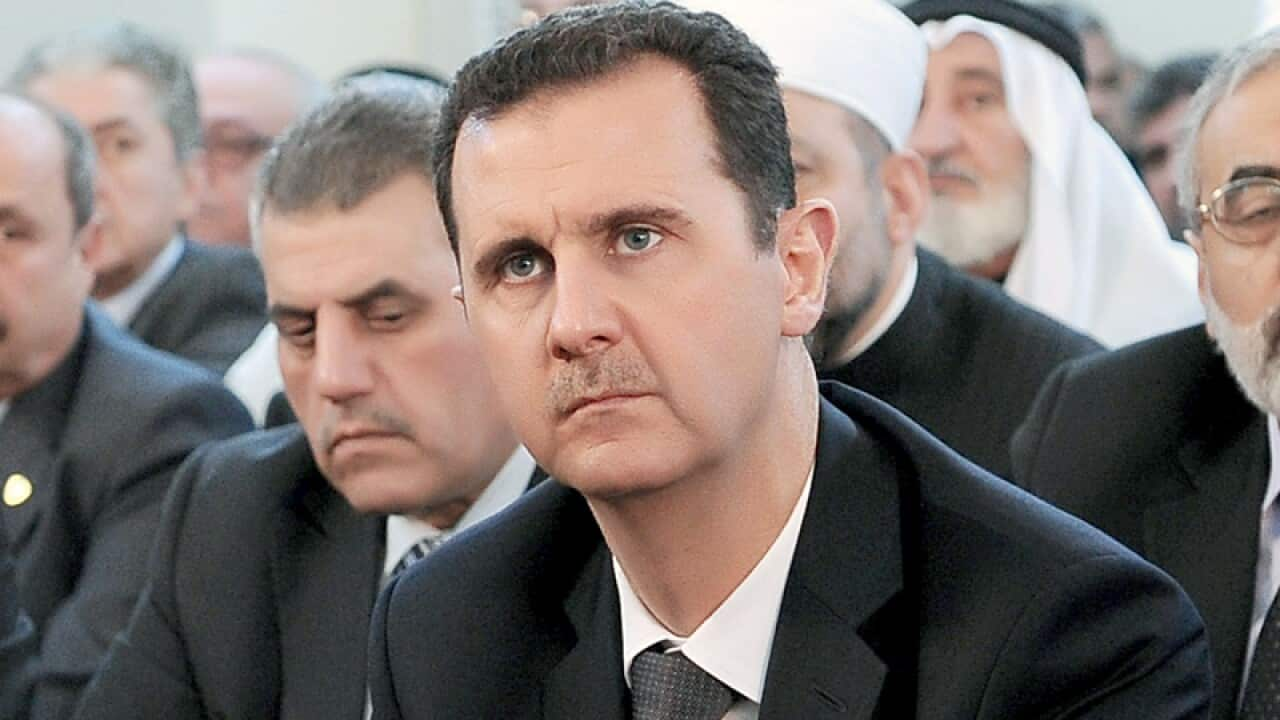Things weren’t looking good for Jamie Robinson and his dog Omi, as stubborn clouds refused to deliver desperately needed rain.
It was 30 December 2019, and Australia’s worst-ever bushfires were coming, but rain wasn’t — and neither was help.
The blackened sky, eye-watering smoke and unimaginable heat indicated the fires were close, but the pair were trapped on Jamie’s property just outside Cobargo in southern NSW.
Jamie was drawn to the property for its beauty and tranquillity, describing it as “healing”: It’s perched on a hilltop among trees and overlooks a mountain known as ‘The Dumpling’.
But that day, the place looked apocalyptic.
Jamie recalls trying to protect his house, which he had only finished building two weeks before, using a garden hose while embers spat down around him for hours. He describes it as “an exercise in futility” — he tried anyway.
His ute wasn’t working, so he called a mate who was a few towns over and asked for a lift out of there. His friend told him, unfortunately, he wouldn’t be able to drive over and to hold tight.
The view from Jamie Robinson’s unfinished house. Source: SBS News / Madeleine Wedesweiler
By this point, Jamie was covered in second-degree burns.
“It would’ve been about 6 or 7pm, and there was an orange way to the west, and I thought it was actually the sun dropping behind a mountain,” he says.
“I went up 15 minutes later and realised, ‘Oh no, that orange mountain’s now on fire’. It was fire, not sunset.”
At around 2am the fire crested the mountains opposite Jamie’s home and he felt a deep sense of foreboding that he wouldn’t be able to escape it.
It was like invisible hands were launching fireballs the size of my ute.
Jamie Robinson
Jamie says the flames were 30 to 40m high and sounded like a music festival.
“Trees are exploding 500m away, and you are feeling it in your sternum … you’re feeling such sonic definition and percussion.”
Fires burned through the NSW town of Cobargo on New Year’s Eve, 2019. Source: Getty / Sean Davey/AFP
Jamie decided to call his family members, thinking it might be the last time he spoke to them.
“The fire was coming down into my valley. It wasn’t looking pretty,” he says.
“So I let a few people know just that ‘I love you’, and making sure that the last words that I said were ones of love. I knew I wasn’t outrunning it.”
Jamie says he was feeling calm, and so was his dog Omi.
The friend Jamie had phoned earlier called back and said he could actually race over and pick Jamie up. He got there “in record time”, and they drove away with just a random handful of clothes, Jamie’s passport and Omi’s medication.
“I’m lucky to be here to tell the tale,” Jamie says.
“There are high chances that if it wasn’t for him coming out, this conversation [with SBS News] potentially wouldn’t be happening.”
The fire raged through the township of Cobargo, destroying historic buildings on its main street.
Eventually returning to his property, Jamie surveyed what was left — ash, mostly.
The melted aluminium gear stick from Jamie Robinson’s Hilux ute. Source: SBS News / Sydney Lang
The windscreen of his ute had melted, as had much of its metal interior.
“Forty-whatever years of life — collections, interests, hobbies, tools, whatever — just gone and made irrelevant in a moment,” Jamie says.
All but 28 timber poles that Jamie had milled for a planned second house were incinerated: the only timber left standing in a dead, smouldering forest.
Jamie is a spiritual guy. He had already survived a fire in Canberra in 2003, in which he lost his house and place of work.
He says the poles’ survival continues to give him hope.
“I’m glad I noticed that because if you can do that with one little itty bit thing, then with the bigger things, you can offer so much more deeper appreciation,” he says.
“I guess it’s looking at the small things again and going, ‘Yeah, that’s pretty good.'”
Jamie Robinson says even though he’s been through a lot, he maintains a smile and a sense of hope. Source: SBS News / Madeleine Wedesweiler
But while the 52-year-old usually has a big smile on his face, life hasn’t been easy for Jamie in the five years since the 2019-20 fires without a house.
He has been living in a donated caravan as he slowly builds the home he’d envisioned before the fires, using the 28 timber poles.
The caravan is hot and small and relies on a noisy generator for power.
Jamie also acknowledges it’s been challenging to watch those around him struggle, as many in the small community of Cobargo suffer ongoing trauma from the fires.
“It’s hard not to get emotional about things. We are human after all, but the acknowledgement of those beautiful things and also the grieving of letting them go, I think that should be held as a healthy process to move on after tears,” he says.
Jamie Robinson has been living in his caravan for the past five years after the fire destroyed his home. Source: SBS News / Sydney Lang
Cobargo, which has a population of around 770 people, over the then-government’s response to the fires.
When then-prime minister Scott Morrison visited in early January, .
“How come we only had four trucks to defend our town? We don’t have a lot of money, but we have hearts of gold, Mr Prime Minister,” Cobargo resident Danielle Murphy told Morrison while holding her goat on a leash in footage that went viral.
Morrison was already facing fierce criticism for taking a holiday to Hawaii while Australia burned that summer and justifying it by saying: “I don’t hold a hose, mate.”
Five years later, people in the community still question whether assistance provided by local, state and federal governments was sufficient.
In the Bega Valley Shire, where Jamie lives, the rebuild rate of homes destroyed by the fires is only around 11 per cent, meaning hundreds of people are still effectively homeless.
Some are sleeping in caravans like Jamie; others are living in sheds and tents.
Mick Brosnan (left) and Jack Gray volunteer with the Social Justice Advocates of the Sapphire Coast. Source: SBS News / Madeleine Wedesweiler
Mick Brosnan is the founder and housing representative of Social Justice Advocates of the Sapphire Coast (SJASC).
He says that of the 464 houses in the Bega Valley Shire destroyed by the Black Summer fires, only around 50 have been rebuilt.
“The rebuild rate is minuscule, and there are lots of reasons for that. We’ve got to remember the people who didn’t want to go back, the people who decided to leave the area, then the people who thought the insurance issues were too great and they didn’t want to hassle anymore,” Mick says.
Further complicating the situation is a large backlog of development applications and the need for people to rebuild their homes to a higher Bushfire Attack Level (BAL) standard due to the risk of future fires.
Building houses with a higher BAL generally costs more money.
Mick says working with people who are deeply traumatised isn’t straightforward either — their needs tend to be complex and unique.
His colleague Jack Gray was in high school when the fires hit Cobargo. The now 21-year-old is one of the youngest members of SJASC and says it’s a problem that vulnerable people are required to complete so much paperwork.
“After the disaster, obviously, a lot of people were left with nothing in terms of wealth or possessions. And so one of the first steps of what people were telling them to do was apply for grants,” Jack says.
Several buildings were destroyed on Cobargo’s main street in the fires. Source: AAP / Sean Davey
Jack describes the rebuilding process as “massive” and says people have to relive the experience “over and over again”.
“People also have to adjust. You’re constantly thinking, ‘Oh, I’ve got this bag. Where’s that? Oh wait, no, I don’t anymore.'”
There’s a lot of trauma related to things like that and a lot of even generational trauma.
Jack Gray
Jack, who was 16 in 2019, says a lot of young people were affected by watching their parents and other adults around them struggle in the aftermath of the fires.
He says they aren’t being supported enough by mental health and community providers.
“We are getting all these other resources in different areas, but the young people still don’t really have anything here,” he says.
“We’ve got family, and we’ve got lovely environments and landscapes, but in terms of what young people are looking for these days, it isn’t here.”
What young people and bushfire survivors of all ages are looking for is affordable housing.
But it’s in short supply — rents have increased by more than 30 per cent in the last five years, and vacancy rates are tight.
The area was already facing a ‘Sydney-esque’ housing crisis, Mick says, but the fires exacerbated it.
Cobargo became the centre of a political debate about how the then-government was handling its bushfire response. Source: SBS News / Sydney Lang
By SJASC’s calculations, the most economical solution proposed to combat homelessness in the area was to place people in “crisis transitional units”, for which the volunteer-run organisation raised more than $500,000.
The two-bedroom, fully self-contained units are double-glazed, insulated and designed to house someone for six months.
But the Bega Valley Shire Council has told the SJASC the caravan-style units are unsafe and unsuitable and advised them to cease the roll-out.
The council referred SBS News to legal advice it published in September regarding the units.
Its chief executive officer, Anthony McMahon, said in a statement: “The legal advice supports the position there is no current legal pathway to approve these particular ‘same day granny flats’ in this configuration and installed in this way under the Local Government Act 1993.”
“The current legislation surrounding these types of structures in NSW is not clear, and the NSW government has commenced a review to hopefully provide greater clarity.”
While a legal stalemate continues regarding the units, Mick says it’s sad that the SJASC can’t house more people, despite having the funds.
The units have been life-changing for some community members, says Mick, citing the example of a family with a newborn who can now sleep safely instead of on the streets.
“They’re in tears when they walk in. It’s just such a relief to have somewhere to rest,” he says.
Mick is concerned about the loneliness experienced by people sleeping rough too. Many of them are .
Then-prime minister Scott Morrison faced harsh scrutiny for holidaying in Hawaii during the fires. Source: Getty / Sean Davey/AFP
“I don’t know how they cope,” Mick says.
In Cobargo, signs of the fire that ripped through the town five years ago are obvious — fences and construction crews line the main street.
Its rebuild has been a long-time coming: the project didn’t start construction until this year.
Even though people banded together almost immediately to get a recovery plan in action, it’s been “a hard, slow road”, Debra Summers says.
Debra wears a lot of hats in Cobargo, volunteering as vice president of the Cobargo Community Bushfire Recovery Fund, community director of the Cobargo Community Development Corporation and founder of Cobargo’s energy transition group.
The first of these organisations raised over $800,000 for some 50 community projects, while the second secured a grant of $9.6 million to rebuild the main street.
Debra Summer is involved in multiple rebuild projects in Cobargo. Source: SBS News / Madeleine Wedesweiler
To start the recovery process, people in these organisations first had to “think outside the box”, Debra says.
“Government wasn’t going to throw huge money at individual landholders. So they came up with this concept of the rebuild being community-owned and through funding and various things bought up the land and some land was donated.”
She says Cobargo’s clean energy transition group is working on a concept to develop a microgrid solar farm with a backup battery, so the town won’t have to rely on the state’s “fragile” energy grid.
“During the bushfires, we had no water, no power, no communications. It was really bad. So we need to look at how we can keep the town powered.”
Debra says people in Cobargo are “bloody determined”.
Her career as a celebrant helped her fall in love with the small community.
“Rather than falling into a pit of despair where I feel like I can’t do much to impact some of that big awful stuff, I can make a difference here in my family, my community, and that’s where my energy goes,” she says.
Like many in the close-knit community, Debra is motivated to continue recovery work by her deep connection to Cobargo.
[I want] to see it flourish again, living and holding the stories of grief and trauma that have happened since the fires.
Debra Summers
Cobargo’s main street rebuild started construction this year. Source: SBS News / Sydney Lang
But some aspects of bushfire recovery support are winding down in the town, and for some, it’s too soon.
Chris Walters was the chair of the recently closed Bushfire Relief Centre in Cobargo.
She says after four and a half years, the volunteer organisation had “done as much as we can”.
“It doesn’t mean that everybody’s been fixed, but we have done as much as possible in terms of face-to-face help with members of the community. And there are still people who need help.”
Chris says people need psychological and financial help well into the future.
“All the studies tell us that when there’s a natural disaster, it takes about 10 years for the community — some people, of course, never do recover,” she says.
“But it’s a very long-term process, and we’re only about halfway through now.”
Some of the funding for Cobargo’s main street rebuild has gone to collectives rather than individual landholders. Source: SBS News / Sydney Lang
Chris says she had no experience in community work, but her reaction was to jump in and support the community that had welcomed her so warmly when she moved there in 2014.
After Morrison visited the Cobargo showground, donations from all over the country started arriving on trucks, distributed and managed by dozens of volunteers.
Debra says his visit was “a gift”.
“His sort of ill-advised drop into town, empty-handed, wanting to claim a bit of spotlight was a bit of a gift because it did put us in the global spotlight. So we were able to put it out there and let people know that we are in need.”
However, Chris says the initial attention and offers of support received by the community quickly dwindled. It’s a big part of why she wanted to set up the relief centre.
“Eventually people had to go back to their own properties and they had to get back to their own lives,” she says.
Chris Walters was the founder of the Cobargo Relief Centre, which closed after serving the community for four and a half years. Source: SBS News / Madeleine Wedesweiler
“Another lady and myself who had been helping out said to each other, ‘Well, this whole thing needs some coordination, and we need to make sure that this continues’. So we kind of looked at each other and went, ‘Yep, we can do that,'” Chris recalls.
Right up until July this year, the centre helped people “coming in with only the shirt on their back”.
Five years isn’t very long, but we’ve come a really, really long way. And I think it just shows the resilience and the toughness of Australians.
Chris Walters
Reflecting on how the fires changed him and the people around him, Jamie says it’s clear the disaster was bigger than the community or any person.
“So, how do you get on from it? Well, it’s not like you could stop it. So you mitigate how you feel, what you can do to help others, what you project.
“My face is a rough face, but it’s got a big arse grin on it.”







